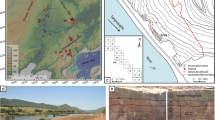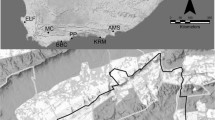Abstract
It is believed that there is a strong link between raw material exploitation and lithic technology. The raw materials play an important role in imposing special technology to hunter gatherers for adapting themselves to their environment. The Zagros region with complex topography, as an island of moisture and the rainfall, provided sufficient food, water and raw material resources. In this paper, we focus on southern Zagros where the compromise between technological needs and the raw material resources in the Dasht-e Rostam-Basht region, led us to propose a model of “optimization of mobility, technological strategies and land use. This model examines this hypothesis that the residents of the region during their seasonal movements for following migratory preys adopted the lamellar technology of the Rostamian in order to minimize time and energy costs associated with raw material procurement and transport. Testing this model in the southern Zagros was based on the techno-typological analysis of the lithic assemblages from the survey sites in the Dasht-e Rostam-Basht region and the stratified lithic assemblages from the Ghār-e Boof Cave.
Similar content being viewed by others
References
Andrefsky WJ (1998) Lithics, macroscopic approaches to analysis. Cambridge University Press, Cambridge
Baumler MF, Speth JD (1993) A Middle Paleolithic assemblage from Kunji cave, Iran. In: Olszewski D, Dibble H (eds) The Paleolithic prehistory of the Zagros-Taurus. The University Museum, University of Pennsylvania, Philadelphia, pp 1–73
Becerra-Valdivia L,Douka K, Comeskey D, Bazgir B, Conard NJ, Marean CW, Ollé A, Otte M,Tumung L, Zeid Mi, Higham TFG, (2017) Chronometric investigations of the Middle to Upper Paleolithic transition in the Zagros Mountains using AMS radiocarbon dating and Bayesian age modelling. J Hum Evol 109:57–69
Bergman CA (2003) Twisted débitage and the Levantine Aurignacian problem. In: Goring-Morris AN, Belfer-Cohen A (eds) More than meets the eyes, studies on Upper Paleolithic diversity in the Near East. Oxbow books, Oxford, pp 185–195
Biglari F (2007) Approvisionnement et utilisation des matières premières au Paléolithique moyen dans la plaine de Kermanshah (Iran): le cas de la Grotte Do-Ashkaft. In: Moncel MH, Moigne A, Arzarello M, Peretto C (eds) Aires ‘approvisionnement en matières premières et aires d’approvisionnement en ressources alimentaires Approche intégrée des comportements, Workshop 23, XV Congrès UISPP, Lisbonne, 5. BAR international series 1725. Oxford University, Oxford, pp 227–239
Binford LR (1979) Organization and formation processes: looking at curated technologies. J Anthropol Res 35:255–273
Blades BS (2001) Aurignacian lithic economy, ecological perspectives from southwestern France. Kluwer Academic/Plenum Publishers, New York
Brantingham PJ (2003) A neutral model of stone raw material procurement. Am Antiq 68(3):487–509
Conard NJ, Ghasidian E, Heydari S, Zeidee M (2006) Report on the 2005 survey of the Tübingen-Iranian Stone Age Research Project in the provinces of Esfahan, Fars and Kohgiluyeh-Boyerahmad. In: Azarnoush M (ed) Archaeological reports 5. The Iranian Center for Archaeological Research, Tehran, pp 9–34
Conard NJ, Ghasidian E, Heydari S, Naderi R, Zeidee M (2007a) The 2006 season of the Tübingen-Iranian Stone Age Research Project in the provinces of Fars and Markazi. In: Fazeli H (ed) 9th annual report of archaeological organisation. ICAR. Iranian Center for Archaeological Research, Tehran, pp 43–67
Conard NJ, Ghasidian E, Heydari-Guran S, Naderi R, Zeidee M (2007b) The 2007 season of the Tübingen-Iranian Stone Age Research Project in Dasht-e Rostam, Fars Province. Unpublished field report. Iranian Center for Archaeological Research, Tehran
Dibble HL (1984) The Mousterian industry from Bisitun Cave (Iran). Paléorient 10(2):23–34
Féblot-Augustins J (1997) Middle and Upper Paleolithic raw material transfers in western and Central Europe: assessing the pace of change. J Middle Atlantic Archaeol 13:57–90
Fisher LE, Eriksen BV (2002) Lithic raw material economy in late glacial and early postglacial western Europe, introduction. In: Fisher LE, Eriksen BV (eds) Lithic raw material economy in late glacial and early postglacial western Europe. BAR international series 1093. Archeopress, Oxford, pp 1–6
Geneste JM (1989) Economie des resources lithiques dans Mousterien du sud-ouest de la France. In: Patou M, Freeman LG (eds) L’Homme de Néandertal 6, la subsistance. ERAUL33. Université de Liège, Liège, pp 75–97
Ghasidian E (2012a) The Rostamian tradition and the Upper Palaeolithic of the Zagros Mountains. In: Hasanzadeh Y, Miri S (eds) Eighty years of Iranian archaeology. Nashr-e Pazineh and National Museum of Iran, Tehran, pp 59–78 (In Persian)
Ghasidian E (2012b) The Upper Palaeolithic of Iran and its place among the South-western Asia. In: Fahimi H, Alizadeh K (eds) Namvarnameh, papers in honor of Masoud Azarnoush. Nashr-e Iran Negar, Tehran, pp 129–141 (In Persian)
Ghasidian E (2014) The Early Upper Paleolithic at Ghār-e Boof Cave; a reconstruction of cultural tradition in the southern Zagros Mountains of Iran. Kerns Verlag, Tübingen
Ghasidian E, Heydari-Guran S (2012) Report on the 2009 survey on the caves and rockshelters of Eslamabad, Sar Pol Zahab and Qasr-e Shirin; Kermanshah district. Iranian Cultural Heritage and Tourism Organization in Kermanshah, Kermanshah (In Persian)
Ghasidian E, Azadi A, Heydari S, Conard NJ (2009) Late Paleolithic cultural traditions in the Basht Region of the Southern Zagros of Iran. In: Otte M, Biglari F, Jaubert J (eds) Iran Paleolithic/Le Paléolithique d’Iran. Proceedings of the XV World Congress UISPP, Lisbonne, 4–9 Sept 06. BAR international series 1968. Archaeopress, Oxford, pp 125–140
Ghasidian E, Bretzke K, Conard NJ (2017) Excavations at Ghār-e Boof in the Fars Province of Iran and its bearing on models for the evolution of the Upper Palaeolithic in the Zagros Mountains. J Anthropol Archaeol 47:33–49
Heydari S (2004) Rohmaterialvorkommen für Stein in Iran Einige Fallstudien. In: Stöllner T, Slotta R, Vatandoust A (eds) Persiens antike Pracht. Bergbau Museum, Bochum, pp 124–129
Heydari S, Azadi A, Ghasidian E (2004) Paleolithic survey in Southwestern Zagros, Basht Valley. Unpublished manuscript. Iranian Center for Archaeological research, Tehran (in Parsi)
Heydari-Guran S (2014) Paleolithic landscapes of Iran. BAR international series 2586. BAR Publishing, Oxford
Heydari-Guran S (2015) Tracking upper Pleistocene human dispersals into the Iranian Plateau: a geoarchaeological model. In: Sanz N (ed) Human origin sites and the world heritage convention in Eurasia. HEADS 4, vol 1. UNESCO publication, Mexico, pp 40–53
Heydari-Guran S, Ghasidian E (2004) Geoarchaeological research in Takht-e Soleyman, travertine context according to new archaeological findings of the late Pleistocene. In: Azarnoush M (ed) Second congress of archaeology of north-west; Urmia. ICAR, Tehran, pp 27–44 (In Persian)
Heydari-Guran S, Ghasidian E (2012) Report on the 2009 survey on the caves and rockshelters of Kermanshah, Dalahoo and Gilan-e Gharb; Kermanshah district. Iranian Cultural Heritage and Tourism Organization in Kermanshah, Kermanshah (In Persian)
Hole F, Flannery K (1967) The prehistory of southwestern Iran: a preliminary report. Proc Prehist Soc 33:147–206
Ikeda J (1979) Preliminary report of an archaeological survey in Arsanjan area, Fars Province, Iran, 1977. Kyoto University, Kyoto
Kuhn SL (1995) Mousterian lithic technology; an ecological perspective. Princeton University Press, Princeton
Miller R (1997) Variability in lithic assemblages across space: differential responses to raw material context. Notae Praehistoricae 17:53–62
Olszewski DI (1993) The Late Baradostian occupation at Warwasi rockshelter, Iran. In: Olszewski D, Dibble H (eds) The Paleolithic prehistory of the Zagros-Taurus. The University Museum, University of Pennsylvania, Philadelphia, pp 186–206
Olszewski DI, Dibble HL (1994) The Zagros Aurignacian. Curr Anthropol 35(1):68–75
Olszewski DI, Dibble HL (2006) To be or not to be Aurignacian: the Zagros Upper Paleolithic. In: Bar-Yosef O, Zilhão J (eds) Towards a definition of the Aurignacian Proceedings of the Symposium held in Lisbon, Portugal, June 25–30, 2002. Instituto Português de Arqueologia Lisboa, Lisbon, pp 355–373
Otte M, Biglari F, Flas D, Shidrang S, Zwyns N, Mashkour M, Naderi R, Mohaseb A, Hashemi N, Darvish J, Radu V (2007) The Aurignacian in the Zagros region: new research at Yafteh Cave, Lorestan, Iran. Antiquity 81:82–96
Otte M, Shidrang S, Flass D (2012) The Aurignacian of the Yafteh Cave and its context (2005-2008 excavations). ERAUL 132. Université de Liège, Liège
Rosenberg M (1988) Paleolithic settlement pattern in the Marv Dasht, Fars Province, Iran. Unpublished Ph.D. dissertation. University of Pennsylvania
Shidrang S (2015) The early Upper Paleolithic of Zagros: Techno-typological assessment of three Baradostian lithic assemblages from Khar Cave (Ghar-e Khar), Yafteh Cave and Pa-Sangar Rockshelter in the Central Zagros, Iran. Unpublished Ph.D. dissertation. Université de Bordeaux
Shott M (1986) Technological organization and settlement mobility: an ethnographic examination. J Anthropol Res 42(1):15–51
Solecki RS (1963) Prehistory in Shanidar Valley northern Iraq. Science 139(1551):179–193
Acknowledgement
The authors are grateful to the university of Tübingen and the Iranian Centre for Archaeological Research. Special thanks go to profs. Nishiaki and Akazawa for making this publication possible and the anonymous reviewers of this paper.
Author information
Authors and Affiliations
Corresponding author
Editor information
Editors and Affiliations
Rights and permissions
Copyright information
© 2018 Springer Nature Singapore Pte Ltd.
About this chapter
Cite this chapter
Ghasidian, E., Heydari-Guran, S. (2018). Upper Palaeolithic Raw Material Economy in the Southern Zagros Mountains of Iran. In: Nishiaki, Y., Akazawa, T. (eds) The Middle and Upper Paleolithic Archeology of the Levant and Beyond. Replacement of Neanderthals by Modern Humans Series. Springer, Singapore. https://doi.org/10.1007/978-981-10-6826-3_11
Download citation
DOI: https://doi.org/10.1007/978-981-10-6826-3_11
Published:
Publisher Name: Springer, Singapore
Print ISBN: 978-981-10-6825-6
Online ISBN: 978-981-10-6826-3
eBook Packages: Social SciencesSocial Sciences (R0)




